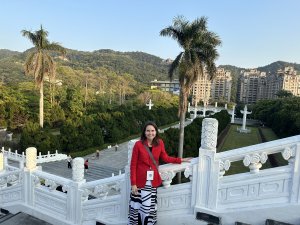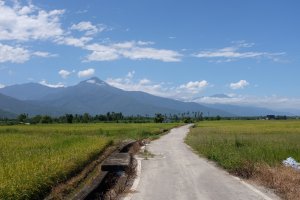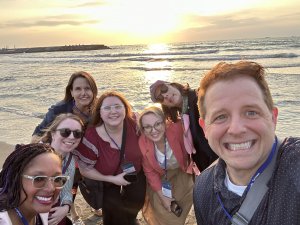
Thanks go to Fulbright! My time in Taiwan has been a truly transformative experience, encompassing many aspects of my life. Beyond the boundaries of my proposed project on character teaching, I have actively contributed to the vibrant community of scholars here, and also experienced personal growth. This report will highlight what I have achieved in my research, my contributions to the community, and the personal gains in beliefs and acquisition of new skills.
Research on Character Teaching
The central focus of my research in Taiwan is character teaching. The Chinese writing system presents the “highest contrast” to alphabetic languages, such as English, due to it being a logographic or morpho-syllabic writing system. Learners whose native language is an alphabetic language have difficulty simultaneously retaining and rapidly retrieving the three aspects of a character (shape, sound, and meaning). Character instruction has long been regarded as the most challenging aspect of language education among Chinese as a Foreign Language (CFL) scholars and practitioners who seek more effective approaches to teaching characters. Therefore, research on character teaching is a significant and pivotal dimension of CFL education. Prior to my arrival in Taiwan, I conducted a comprehensive study on the existing literature regarding character teaching at the level of course design and overall curriculum design for CFL program. As part of my Fulbright project, I aim to design and develop the most effective methods for teaching characters using Augmented Reality (AR). This project encompasses multiple levels of learning and research. To complete the project, I was guided by two fundamental questions: (1) What are the best available methods for teaching characters? (2) How do we design and develop materials for character teaching?
My efforts to find the best available methods for teaching characters involved interviews and follow-up discussions with experts in character teaching and a survey of the professional literature. I had the opportunity to visit two professors and one teacher, Dr. Lin Zhen-Xing, Dr. Change Li-Yun, and Lee Chia-Yun at National Taiwan Normal University (NTNU). Both faculty members specialize in character learning and are involved in CFL teacher education, especially methods of teaching characters. Jia-Yun, Dr. Chang’s graduate student, is completing her thesis on character teaching and teaches character courses at the Mandarin Teaching Center at NTNU. Additionally, I attended Dr. Huang Pei-Jong’s seminar for graduate students titled “Methodology in Character Teaching” at National Taiwan University (NTU) in the spring of 2023. Conversations with these experts greatly enhanced my understanding of character teaching practices in Taiwan.
Dr. Huang is regarded as one of the most distinguished researchers on character teaching in the world. Prior to my arrival in Taiwan, I had read his book, The Theory and Practice of Character Teaching, multiple times. Attending his seminar and lectures, as well as participating in discussions with the students and Professor Huang, proved to be highly rewarding. It is worth noting that this was the final offering of Professor Huang’s class, after teaching it for more than 10 years following his retirement. During the seminar, he shared new research findings that will be published in his forthcoming book. These latest research results were inspirational and enlightening, providing valuable insights for my own research.
During my stay in Taiwan, I have completed two scholarly publications, one of which is currently under review for a prestigious peer-reviewed journal, while the other, co-authored with Dr. Da Jun, is scheduled to be published in a peer-reviewed scholarly book. The first article is titled “Effective Character Teaching Methods for L1 English Chinese-as-a-Foreign-Language Learners: A Review of Empirical Research.” This synthesis study involved an exhaustive literature search spanning from 1952 to the present, focusing on character instruction for L1 English CFL learners. The search identified 22 empirical studies, which were analyzed with regard to research methods, learners’ proficiency levels, the contexts for learning, methodological approaches, and theoretical foundations. The analysis revealed a notable increase in the number of studies on character teaching methods over the past decade, highlighting the significance of technology in the development of these methods. Among the 39 methods examined in the literature, six categories of instructional methods for teaching characters were identified. Within five of these categories, effective methods were identified, described, and discussed.
The second review article is tentatively titled “Technology-Enhanced Character Teaching: A Review of Empirical Studies.” This article examines the utilization of technology in supporting Chinese character teaching, while also providing suggestions for future directions in this field. To offer a comprehensive view of technology-assisted character teaching, an exhaustive search was conducted using four databases: Linguistics and Language Behavior Abstracts (LLBA), ERIC, PsychInfo, and Education Index Retrospective. Additionally, manual searches were conducted to screen relevant titles, gather articles from essential journals, and identify references cited in individual articles. The manual search aimed to identify any articles that the initial database search might have overlooked. A total of 24 articles were identified and were cross analyzed with a focus on understanding which aspects of character teaching were targeted for improvement through the application of various types of technology. The completion of these two review articles has provided me with an in-depth overview of the pedagogical research, which has been conducted on character teaching within CFL education.
As part of the preceding research, I studied characters systematically to find the internal connections and logic among them and to explore how to design and develop materials for character teaching. While I am still examining the necessary tools and interfaces related to AR that may be required to implement course design, my research suggests a significant potential for AR for student self-learning and for board games for classroom activities to enhance character teaching and learning.
Throughout the academic year 2022-2023, I attended the Paleography class (Figure 1) taught by Professor Hsu Fu-Chang, an expert in Paleography and CFL character teaching, at NTU. This course is essential and mandatory for undergraduate students majoring in Chinese language and literature, spanning two semesters. Professor Hsu systematically instructed us on the development of Chinese characters, their fundamental features, and the six categories of Chinese characters. By attending this course, I gained a comprehensive and systematic understanding of Chinese characters.

Visits to the CFL courses, discussions with faculty, and my research during my Fulbright in Taiwan have also led to a new book project. This book is written for CFL learners who are learning Chinese in the United States. Its purpose is to teach characters to this group of students in a humorous and engaging way, with the assistance of technology. The book aims to help students learn a brief history of the Chinese writing system, understand the main features of characters, and grasp the inner logic and connections of basic characters easily. Currently, the first draft of the book is halfway written.
The availability of materials on study of Chinese characters in local bookstores and libraries provided an abundance of resources that are unimaginable in the U.S. I have fully utilized these rich resources to aid my character learning journey. During numerous trips to Eslite bookstore and the Main/Branch Libraries of Taipei, I gathered all of the books and resources needed for my research projects.
During my stay in Taipei, I had the opportunity to meet and engage with esteemed scholars in the fields of CFL and Computer-Assisted Language Learning, both from Taiwan and around the world. These scholars include Dr. Dorothy Chun from UC-Santa Barbara, Drs. Lan, Yu-Ju, Lin Zhen-Xing, and Chang Li-Yun from NTNU, Dr. Meng Zhu-Yi, a visiting scholar at NTNU from Korean University of Foreign Languages, Drs. Chang Li-Ping, Huang Pei-Jong, and Hsu Fu-Chang from NTU, Dr. Tao Hongyin from UCLA, and Dr. Joel Bellassen from Institut National des Langues et Civilisations Orientales in France. Engaging in conversations with these scholars has been truly inspiring for both my project and personal growth. Moreover, attending seminars, conferences, and workshops allowed me to interact with renowned scholars and researchers in the field of education. These interactions not only enriched my knowledge, but also provided valuable networking opportunities, fostering professional growth and opening doors for potential future collaborations.
Involvement in Local Learning Community
I have actively participated in academic forums and discussions including talks and seminars by Dr. Meng Zhuyi on culture in language education, Dr. Dorothy Chun from the U.S. on using of Virtual Reality in Second Language Acquisition (SLA), Dr. Linda Bradley from Sweden on designing digital apps for new language learners, Dr. Cheng Pei-Yu on the use of Chat-GPT in SLA in Dr. Lan’s seminar, Dr. Baren J. ter Haar from Germany on translation of Chinese terminology in religion, and Dr. Tao Hongyin on conversational analysis in CFL. I also attended the 21st International Annual Conference of Teaching CSL held at NTNU in December, and will attend the symposium Dr. Lan organized on technology and SLA in mid-June. See Figure 2.
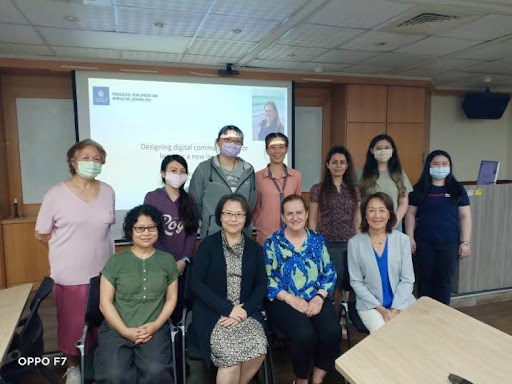
During my stay in Taiwan, I was honored by invitations to give two talks: one at NTU invited by the Chinese as a Second Language (CSL) program director, Dr. Chang Li-Ping, and one at NTNU invited by the CSL Department Chair, Dr. Hong Jia-Fei, respectively. The talk at NTU was titled “A Systematic Review of Pedagogical Research on Teaching CFL in the U.S. – From 1960 to 2020 & The Mostly Commonly Used Research Methods in CFL Pedagogical Research.” I shared my research findings regarding trends in pedagogical research in CFL and two of the most widely used research designs in CFL in the U.S.: the quasi-experimental design and the exploratory research design. At the end of the talk, I answered questions from the audience, the majority of whom were students in the M.A. program in CSL at NTU. See Figure 3.
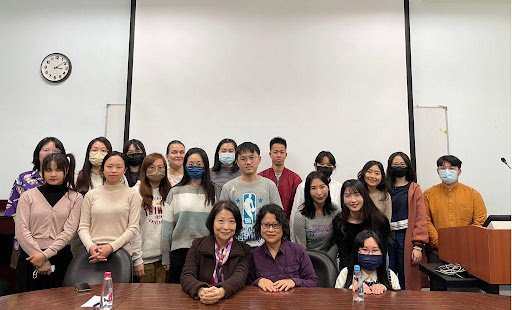
The talk at NTNU was titled “Enhancing Grammar Learning with a Multimedia Instructional Module: Design and Teaching of “Shì…de” Construction for CFL Learners.” This talk focused on how to design a digital module for teaching a very challenging grammar point, i.e., “shì…de.” The information provided in this talk was also helpful for teaching this grammar point in a face-to-face classroom setting. The majority of the audience were doctoral students in the CSL program at NTNU. See Figure 4.

Furthermore, I had the privilege of being invited by Dr. Chang Li-Ping to observe and provide feedback on the practice teaching sessions conducted by her graduate students in the CSL program at NTU. I was delighted to participate in this opportunity as it allowed me to gain further insights into the CSL teacher training in Taiwan. Moreover, I was able to contribute my expertise in CSL and teacher training to the learning community in Taiwan, fostering an exchange of knowledge and experience in this field.
Personal Growth
My time in Taiwan has been incredibly transformative, not just in terms of my academic pursuits but also in fostering significant personal growth. Immersed in a new cultural environment, I embraced the opportunity to expand my horizons, challenge my preconceptions, and broaden my perspectives. There are several experiences that have had a profound influence on my personal life: my exploration and practice of Buddhism, my venture into learning drawing and martial arts, and my travel experiences.
First, my understanding of Buddhism has significantly deepened during my time in Taiwan. Over the past few years, I have developed a keen interest in Buddhism, and I consider myself incredibly fortunate to have had the opportunity to live in Taiwan for 10 months, where the religious atmosphere, particularly in relation to Buddhism, is vibrant. To nurture my emerging beliefs, I have visited numerous Buddhist temples seeking spiritual inspiration.

To further expand my knowledge and understanding of Buddhism, I audited Dr. Lee Hsing-Ling’s Introduction to Buddhism course at NTNU during the spring semester. This course provided a systematic and comprehensive study of Buddhism and fostered a better understanding of its principles, practices, and philosophies. I am grateful for the chance to learn from Dr. Lee and other experts in the field, both in terms of practical application and theoretical insights. I gained a deeper understanding of mindfulness, compassion, and inner peace. Through meditation and studying Buddhist philosophy, I have found valuable insights and practical techniques that have positively impacted my daily life and overall well-being. The opportunity to learn about Buddhism in Taiwan is undeniably one of the most transformative experiences I have had, and I am truly grateful for it.
Second, during my time in Taiwan, I have embarked on a journey of learning drawing and martial arts, and these pursuits have had a profound impact on my personal growth. Engaging in artistic expression through drawing has nurtured my creativity while also instilling discipline, focus, and perseverance. As I was working on my book, which involved drawing the etymology of characters and components, I realized that drawing skills were essential. Fortunately, I had the privilege of seeing Dr. Nadeau’s impressive art of drawing, which served as inspiration and sparked my interest in learning to sketch. From the moment I started, I found a deep passion for this practice. Learning to draw has taught me to see the world as it truly is. The ability to observe and capture the essence of what I’m sketching is the first step in creating a meaningful piece of art. The drawing skills I have acquired in Taipei will undoubtedly benefit me in completing my book, but more importantly, they have honed my ability to perceive the world around me accurately—a vital skill for life in general. Moreover, drawing offers me a way to engage my brain in a completely different realm from academic pursuits, providing a sense of balance and fulfillment. See Figure 6.

My experience learning martial arts emerged from a serendipitous discovery and it has had a profoundly positive impact on my life. It not only serves as a similar outlet to drawing, providing a much-needed distraction from the academic aspect of my life, but also helps me develop physical strength and coordination. I found the martial art team and my teacher in the Da’an Forest Park, where I frequently go jogging. Among the various morning activity groups, one particular group caught my attention because the martial art they performed not only has a beautiful form but also reflects inner strength and flexibility. I later found out that they practiced White Crane Fist led by Mr. Luo Hai-Yang, with assistance from Mr. Li Zhen-Cheng. Intrigued, I sought their permission to join them. Mr. Luo graciously welcomed me into their group, and under his guidance and Mr. Li’s instruction, I have learned Feeding Crane, Sleeping Crane, and Flying Crane forms. Additionally, Mr. Li has taught me the Bagua Blade form (Figure 7) and Dajiao-Gongjian fist. Learning Chinese martial arts in my hometown in the USA would have been inconceivable, and I am glad I received this opportunity.
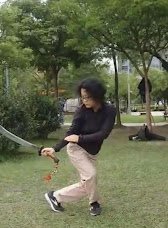
In addition to martial arts, I have also had the opportunity to attend Dr. Cheng Tsan-Shan’s Chinese Classical Philosophy class in the spring semester. This class has provided me with a systematic understanding of Chinese philosophy during the Han and Wei Jin Dynasties. I also had a chance to learn Chinese calligraphy from Ms. Huang. Martial arts, Chinese philosophy, and Calligraphy are representative of Chinese culture and I am thinking of teaching what I have learned to my students in the United States, which will enhance the cultural communication between Taiwan and the United States.

Lastly, the opportunity to travel within Taiwan and explore its diverse landscapes and vibrant cities has been truly enriching. Each new destination has offered unique cultural experiences, allowing me to immerse myself in local traditions, taste new cuisines, and interact with people from different backgrounds. During the winter break, my son and I had the opportunity to travel to Tainan, Kaohsiung, and Kenting. Although our trip ended earlier than planned due to catching COVID-19, we still managed to learn a great deal about Taiwan and thoroughly enjoyed the experience. Additionally, exploring various parts of Taipei during weekends has been immensely rewarding. We visited places such as Ximending, the National Palace Museum, Bamboo Lake (Figure 9), the Elephant and the Tiger Mountains, Chiang Kai-Shek Shilin Residence, Tianmu Hiking Trail, and Raohe Night Market, among others. These travel experiences have broadened my worldview and fostered a sense of curiosity and appreciation for different cultures.

During my travels, I have encountered numerous remarkable Taiwanese individuals. Their kindness and hospitality have touched me deeply. I have frequently shared my experiences on social media with my friends from mainland China and the United States so that they gain a greater understanding of the magnificence of Taiwan and the remarkable people who live on this island.
Overall, my time in Taiwan has been a transformative period of self-discovery, cultural immersion, and personal growth. It has expanded my understanding of the world and offered an environment in which I could become a more open-minded and well-rounded individual. I am immensely grateful for the opportunities and experiences that this chapter of my life has brought forth.
I am greatly thankful to Fulbright for granting me the opportunity to spend 10 months in Taiwan. As the preceding narrative indicates, this experience has had a profound impact on multiple aspects of my life. In closing, I would like to express my heartfelt gratitude to Dr. Randall Nadeau, Ms. Charlie Cheng, Ms. Erin Lin, Mr. Kevin Chao, and all the other Fulbright staff members who have provided invaluable support and assistance throughout my stay. Without their guidance and help, my time in Taiwan would not have been as rewarding and fulfilling. I will cherish this experience for the rest of my life and will undoubtedly miss it dearly.
Managing Editor: Jackie Hardwick


